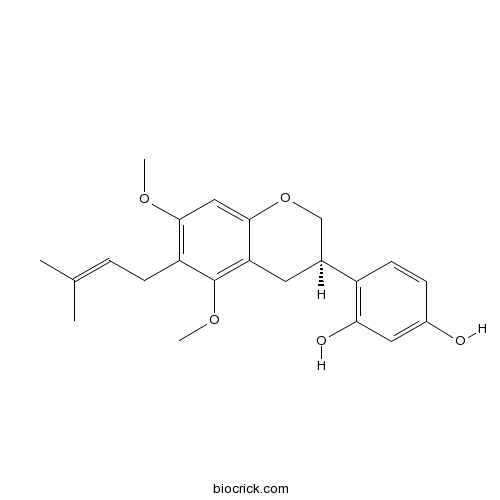Glyasperin DCAS# 142561-10-2 |

Quality Control & MSDS
3D structure
Package In Stock
Number of papers citing our products

| Cas No. | 142561-10-2 | SDF | Download SDF |
| PubChem ID | 480860 | Appearance | Powder |
| Formula | C22H26O5 | M.Wt | 370.44 |
| Type of Compound | Flavonoids | Storage | Desiccate at -20°C |
| Solubility | Soluble in Chloroform,Dichloromethane,Ethyl Acetate,DMSO,Acetone,etc. | ||
| Chemical Name | 4-[(3R)-5,7-dimethoxy-6-(3-methylbut-2-enyl)-3,4-dihydro-2H-chromen-3-yl]benzene-1,3-diol | ||
| SMILES | CC(=CCC1=C(C=C2C(=C1OC)CC(CO2)C3=C(C=C(C=C3)O)O)OC)C | ||
| Standard InChIKey | DDMAUIOCNQXFHL-AWEZNQCLSA-N | ||
| Standard InChI | InChI=1S/C22H26O5/c1-13(2)5-7-17-20(25-3)11-21-18(22(17)26-4)9-14(12-27-21)16-8-6-15(23)10-19(16)24/h5-6,8,10-11,14,23-24H,7,9,12H2,1-4H3/t14-/m0/s1 | ||
| General tips | For obtaining a higher solubility , please warm the tube at 37 ℃ and shake it in the ultrasonic bath for a while.Stock solution can be stored below -20℃ for several months. We recommend that you prepare and use the solution on the same day. However, if the test schedule requires, the stock solutions can be prepared in advance, and the stock solution must be sealed and stored below -20℃. In general, the stock solution can be kept for several months. Before use, we recommend that you leave the vial at room temperature for at least an hour before opening it. |
||
| About Packaging | 1. The packaging of the product may be reversed during transportation, cause the high purity compounds to adhere to the neck or cap of the vial.Take the vail out of its packaging and shake gently until the compounds fall to the bottom of the vial. 2. For liquid products, please centrifuge at 500xg to gather the liquid to the bottom of the vial. 3. Try to avoid loss or contamination during the experiment. |
||
| Shipping Condition | Packaging according to customer requirements(5mg, 10mg, 20mg and more). Ship via FedEx, DHL, UPS, EMS or other couriers with RT, or blue ice upon request. | ||
| Description | 1. Glyasperin D possesses weak anti-Helicobacter pylori activity. |
| Targets | Antifection |

Glyasperin D Dilution Calculator

Glyasperin D Molarity Calculator
| 1 mg | 5 mg | 10 mg | 20 mg | 25 mg | |
| 1 mM | 2.6995 mL | 13.4975 mL | 26.9949 mL | 53.9898 mL | 67.4873 mL |
| 5 mM | 0.5399 mL | 2.6995 mL | 5.399 mL | 10.798 mL | 13.4975 mL |
| 10 mM | 0.2699 mL | 1.3497 mL | 2.6995 mL | 5.399 mL | 6.7487 mL |
| 50 mM | 0.054 mL | 0.2699 mL | 0.5399 mL | 1.0798 mL | 1.3497 mL |
| 100 mM | 0.027 mL | 0.135 mL | 0.2699 mL | 0.5399 mL | 0.6749 mL |
| * Note: If you are in the process of experiment, it's necessary to make the dilution ratios of the samples. The dilution data above is only for reference. Normally, it's can get a better solubility within lower of Concentrations. | |||||

Calcutta University

University of Minnesota

University of Maryland School of Medicine

University of Illinois at Chicago

The Ohio State University

University of Zurich

Harvard University

Colorado State University

Auburn University

Yale University

Worcester Polytechnic Institute

Washington State University

Stanford University

University of Leipzig

Universidade da Beira Interior

The Institute of Cancer Research

Heidelberg University

University of Amsterdam

University of Auckland

TsingHua University

The University of Michigan

Miami University

DRURY University

Jilin University

Fudan University

Wuhan University

Sun Yat-sen University

Universite de Paris

Deemed University

Auckland University

The University of Tokyo

Korea University
- A 484954
Catalog No.:BCC6203
CAS No.:142557-61-7
- Sageone
Catalog No.:BCN3144
CAS No.:142546-15-4
- Cimidahurinine
Catalog No.:BCN6229
CAS No.:142542-89-0
- 1,2,3,4,7-Pentamethoxy-9H-xanthen-9-one
Catalog No.:BCN1570
CAS No.:14254-96-7
- L-690,330
Catalog No.:BCC5666
CAS No.:142523-38-4
- L-690,488
Catalog No.:BCC5667
CAS No.:142523-14-6
- MK-5172 sodium salt
Catalog No.:BCC1765
CAS No.:1425038-27-2
- 19-Nortestosterone acetate
Catalog No.:BCC8445
CAS No.:1425-10-1
- Glyasperin A
Catalog No.:BCN6228
CAS No.:142474-52-0
- 3-O-beta-D-apiofuranosyl(1-2)-beta-D-glucopyranosyl rhamnocitrin 4-O-beta-D-glucopyranoside
Catalog No.:BCN8141
CAS No.:142473-99-2
- Amthamine dihydrobromide
Catalog No.:BCC6744
CAS No.:142457-00-9
- Lobetyolinin
Catalog No.:BCN3322
CAS No.:142451-48-7
- Calanolide E
Catalog No.:BCN6230
CAS No.:142566-61-8
- Asperuloside
Catalog No.:BCN6231
CAS No.:14259-45-1
- Narirutin
Catalog No.:BCN6300
CAS No.:14259-46-2
- Didymin
Catalog No.:BCN3327
CAS No.:14259-47-3
- Deacetylasperulosidic acid
Catalog No.:BCN3323
CAS No.:14259-55-3
- Daphylloside
Catalog No.:BCN6232
CAS No.:14260-99-2
- Macrocarpal C
Catalog No.:BCN6233
CAS No.:142628-53-3
- Macrocarpal E
Catalog No.:BCN6234
CAS No.:142628-54-4
- Macrocarpal D
Catalog No.:BCN6235
CAS No.:142647-71-0
- 6-Hydroxykaempferol 3,6-diglucoside
Catalog No.:BCN3335
CAS No.:142674-16-6
- Genkwanol B
Catalog No.:BCN8013
CAS No.:142674-67-7
- Macrocarpal B
Catalog No.:BCN6236
CAS No.:142698-60-0
Anti-Helicobacter pylori flavonoids from licorice extract.[Pubmed:12127165]
Life Sci. 2002 Aug 9;71(12):1449-63.
Licorice is the most used crude drug in Kampo medicines (traditional Chinese medicines modified in Japan). The extract of the medicinal plant is also used as the basis of anti-ulcer medicines for treatment of peptic ulcer. Among the chemical constituents of the plant, glabridin and glabrene (components of Glycyrrhiza glabra), licochalcone A (G. inflata), licoricidin and licoisoflavone B (G. uralensis) exhibited inhibitory activity against the growth of Helicobacter pylori in vitro. These flavonoids also showed anti-H. pylori activity against a clarithromycin (CLAR) and amoxicillin (AMOX)-resistant strain. We also investigated the methanol extract of G. uralensis. From the extract, three new isoflavonoids (3-arylcoumarin, pterocarpan, and isoflavan) with a pyran ring, gancaonols A[bond]C, were isolated together with 15 known flavonoids. Among these compounds, vestitol, licoricone, 1-methoxyphaseollidin and gancaonol C exhibited anti-H. pylori activity against the CLAR and AMOX-resistant strain as well as four CLAR (AMOX)-sensitive strains. Glycyrin, formononetin, isolicoflavonol, Glyasperin D, 6,8-diprenylorobol, gancaonin I, dihydrolicoisoflavone A, and gancaonol B possessed weaker anti-H. pylori activity. These compounds may be useful chemopreventive agents for peptic ulcer or gastric cancer in H. pylori-infected individuals.


